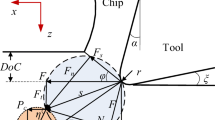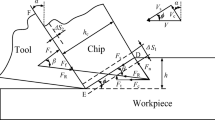Abstract
The analytical model of residual stress in orthogonal cutting proposed by Jiann is an important tool for residual stress prediction in orthogonal cutting. In application of the model, a problem of low precision of the surface residual stress prediction is found. By theoretical analysis, several shortages of Jiann’s model are picked out, including: inappropriate boundary conditions, unreasonable calculation method of thermal stress, ignorance of stress constraint and cyclic loading algorithm. These shortages may directly lead to the low precision of the surface residual stress prediction. To eliminate these shortages and make the prediction more accurate, an improved model is proposed. In this model, a new contact boundary condition between tool and workpiece is used to make it in accord with the real cutting process; an improved calculation method of thermal stress is adopted; a stress constraint is added according to the volume-constancy of plastic deformation; and the accumulative effect of the stresses during cyclic loading is considered. At last, an experiment for measuring residual stress in cutting AISI 1045 steel is conducted. Also, Jiann’s model and the improved model are simulated under the same conditions with cutting experiment. The comparisons show that the surface residual stresses predicted by the improved model is closer to the experimental results than the results predicted by Jiann’s model.
Similar content being viewed by others
References
El-Axir M H. A method of modeling residual stress distribution in turning for different materials. International Journal of Machine Tools & Manufacture, 2002, 42(9): 1055–1063
Fuh K H, Wu C F. A residual-stress model for the milling of aluminum alloy (2014-T6). Journal of Materials Processing Technology, 1995, 51(1–4): 87–105
Ee K C, Dillon O W Jr, Jawahir I S. Finite element modeling of residual stresses in machining induced by cutting using a tool with finite edge radius. International Journal of Mechanical Sciences, 2005, 47(10): 1611–1628
Merwin J E, Johnson K L. An analysis of plastic deformation in rolling contact. Proceedings of the Institution of Mechanical Engineers, 1963, 177(1): 676–690
Jiang Y, Sehitoglu H. An analytical approach to elastic-plastic stress analysis of rolling contact. Journal of Tribology, 1994, 116(3): 577–587
Ulutan D, Erdem Alaca B, Lazoglu I. Analytical modelling of residual stresses in machining. Journal of Materials Processing Technology, 2007, 183(1): 77–87
Lazoglu I, Ulutan D, Alaca B E, et al. An enhanced analytical model for residual stress prediction in machining. CIRP Annals-Manufacturing Technology, 2008, 57(1): 81–84
Su J C. Residual stress modeling in machining processes. Dissertation for the Doctoral Degree. Atlanta: Georgia Institute of Technology, 2006
Komanduri R, Hou Z B. Thermal modeling of the metal cutting process: Part I—Temperature rise distribution due to shear plane heat source. International Journal of Mechanical Sciences, 2000, 42(9): 1715–1752
McDowell D L. An approximate algorithm for elastic-plastic twodimensional rolling/sliding contact. Wear, 1997, 211(2): 237–246
Waldorf D J. Shearing, ploughing, and wear in orthogonal machining. Dissertation for the Doctoral Degree. Urbana-Champaign: University of Illinois, 1996
Saif M T A, Hui C Y, Zehnder A T. Interface shear stresses induced by non-uniform heating of a film on a substrate. Thin Solid Films, 1993, 224(2): 159–167
Author information
Authors and Affiliations
Corresponding author
Rights and permissions
About this article
Cite this article
Qi, Z., Li, B. & Xiong, L. Improved analytical model for residual stress prediction in orthogonal cutting. Front. Mech. Eng. 9, 249–256 (2014). https://doi.org/10.1007/s11465-014-0310-1
Received:
Accepted:
Published:
Issue Date:
DOI: https://doi.org/10.1007/s11465-014-0310-1




